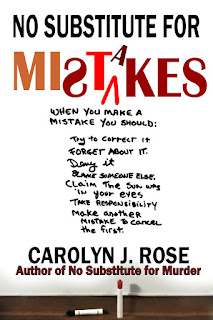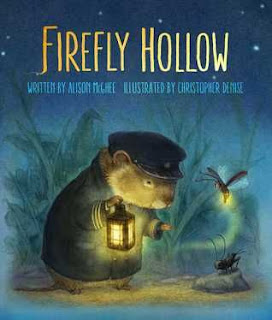A Most Extraordinary Lady
As storytellers, we all have people who have been instrumental in our development as writers. My guest today is mystery author
Carolyn J. Rose; she is definitely one of those special people in my life. I met Carolyn during my first creative writing course at Clark College (after my departure from dental hygiene).
Right from the very first class
I knew she was special. Not only did she inform and inspire her students, she did it with humor and humility. For that reason, I'm thrilled that Carolyn has agreed to allow me to interview her today on
Writ of Whimsy - it's long overdue!
But first, here is the cover image and back cover description for Carolyn's latest mystery novel,
No Substitute For Myth:
Is Bigfoot prowling around Reckless River, Washington? Has Sasquatch come to the city?
Barbara Reed doesn’t know if she believes the legendary creature exists, but evidence is stacking up. Something big is scavenging for food in city parks. Something tall and heavy left footprints across a dirt parking lot. And something huge and hairy careened into her one night on the riverfront trail.
Did that same creature kill a man and drag his body into a swamp? Or was the killer human? Will justice be undermined by media frenzy, a tide of tourism, and hundreds of hunters?
With help from the usual suspects, Barb, her drug-cop boyfriend, her pearl-powered wealthy neighbor, and Cheese Puff, her less-than-loyal dog, set out to solve a mystery, catch a murderer, and bust a few myths along the way.
(NO SUBSTITUTE FOR MYTH is the sequel to NO SUBSTITUTE FOR MURDER, NO SUBSTITUTE FOR MONEY, and NO SUBSTITUTE FOR MATURITY)
* * * * * * * * * * * * * * * * *
Welcome to
Writ of Whimsy, Carolyn! Thanks so much for taking the time to participate in this interview. This is a surreal experience for me; I never would have thought I'd be interviewing my teacher.
CJR - Don't think of me as a teacher, think of me as someone who distilled what I'd learned and passed it along with the hope some of it would be helpful. And think of me as someone who egged you on to write, write, write.
VL - You definitely did that! I'd like to begin by having you give us an overview of your early beginnings and history as an author, Carolyn.
CJR - When I was ten I started writing stories for myself and one of my cousins. I also started telling myself that one day I'd be a "real" writer. When I was 16, I sold a poem to
Seventeen and won a community writing competition.
Then I lost momentum. I went off to college, went into Volunteers in Service to America, got a job in television news, got married, got divorced, got another job in another state, got married, moved again, and again, and again. Well, you get the picture.
I didn't have a lot of time or energy to write until the early 1990s when I carved out a couple of hours a week, took classes from Elizabeth Lyon (author of
Manuscript Makeover and several other books on writing craft) and started a mystery. It was a learning book and, after a few years of tinkering with it, I tossed it. After that I wrote three mysteries set in TV newsrooms - all now out of print and going to stay that way because they were also learning books.
During the late 1990s, my husband (Mike Nettleton) and I wrote as a team, producing five books:
The Hard Karma Shuffle, The Crushed Velvet Miasma,
Death at Devil's Harbor (originally published as
The Big Grabowski),
Deception at Devil's Harbor (originally published as
Sometimes a Great Commotion), and
Drum Warrior (originally published as
The Hermit of Humbug Mountain). Starting around 2001, we published them through several small presses: Deadly Alibi Press, SynergEbooks, and Krill Press. A few years ago we got our rights back. We revised the books and published them on our own.
In 2001, shortly after we moved to Vancouver, the news operation I worked for folded. It was a financial blow, but being laid off gave me time to focus on what I wanted to do with the rest of my life. I abandoned my career as a TV news producer and assignment editor and got certified as a substitute teacher. Then I wrote a project on my own, a dark mystery set in the Catskill Mountains. It became
Hemlock Lake and, after years of querying agents and then publishers, it was released by Five Star in 2010.
When Five Star turned down a second book, I decided I couldn't face more years of querying and rejection, so I jumped into independent publishing with
An Uncertain Refuge. My sales encouraged me to keep going with sequels to that book and to
Hemlock Lake, as well as a love story,
A Place of Forgetting.
My most successful book has been
No Substitute for Murder, a cozy based in Reckless River, Washington, a town much like Vancouver. It features amateur sleuth Barbara Reed, a substitute teacher. Despite the fact that I do very little promotion and have never participated in free download programs, nearly 40,000 readers - some as far away as South Africa, Pakistan, Brazil, and New Zealand - have downloaded the book. Many have written to tell me how much they enjoyed the characters - especially Cheese Puff, Barb's entitled dog. That connection with readers means more to me than the paychecks.
In November I will publish book #20.
No Substitute for Mistakes, the fifth in the Subbing isn't for Sissies Series.
VL - Gosh, Carolyn, I'm learning so much about you that I never knew. You've been in this business for quite a while. Could you tell me a few of the significant changes you've seen in the world of publishing in that time?
CJR - The rise of indie publishing is the big thing. Competition for readers is increasing all the time. I think it's wonderful that writers can write the books they want to write and put them out there without going the traditional-publishing route. A good story told well will find an audience.
But at the same time, I think there's a lot to be learned from the process of searching for an agent or publisher. It can be time-consuming and painful, but the feedback can help polish your pitch and your work.
I also think anyone who wants to roll on the indie road should make a supreme effort to upload a manuscript that's well-formatted and as free of errors as possible.
VL - Great advice, Carolyn. Since you've been traditionally published, as well as independently published, could you give us some insights on what you've learned from both experiences?
CJR - Years ago I had experiences with two agents. Both gave me sound advice about character development. I didn't realize how much one of my characters moped and moaned until Agent #1 pointed it out.
But Agent #1 was terrible at keeping in touch and often seemed to drop off the map for months, so I ended our association. I queried again and found Agent #2 who sold one of the books Mike and I wrote together. We were walking on air for months, waiting for a contract. Then we learned the division that wanted the book had folded before the contract was negotiated. Discouraged, we stuck with Agent #2 for another year until she told me she couldn't represent
Hemlock Lake because it was a rural book and she was a city girl. Because the themes of the book are universal, I'm still puzzling over that.
Meanwhile, we'd "sold" several books to small presses. I say "sold" because there was no money up front, only royalties on sales. We liked the publishers and got a lot of guidance about covers and blurbs and promotion. We also learned exactly how hard a small-press author - and almost every other author who isn't already published - has to work to make even a tiny ripple in the publishing pond.
It was valuable experience and helps me now that I'm "on my own." I miss not having the support and guidance of an agent or publisher, but I don't miss the feeling that the book is no longer completely mine.
VL - Carolyn, how have you managed to write so many books, while still substitute teaching?
CJR - B.I.C. Backside in chair. I take time, I make time, and I try to use time wisely and not think about household tasks that ought to be done.
Also, the great thing about being a substitute teacher is that when the final bell rings, and teachers go to a staff meeting or pack up a load of papers to take home to grade, I skip out the door (sometimes literally) and come home to walk the dogs, get a snack and write. Plus, there's no work in the summer, so I can buckle down and write 6-8 hours a day.
VL - How do you maintain such consistent motivation to write?
CJR - Part of my motivation comes from the kid inside of me who wanted to be a writer. And part comes from my characters. They pop up in my dreams with ideas for what they want to do next. They're a pushy bunch and right now are helping me with
No Substitute for Motive, the 6th book in the Subbing isn't for Sissies Series.
Thanks for this informative and inspiring interview, Carolyn! I'd also like to thank you for your friendship and support; I know you've offered the same to numerous other writers in our community. You're the best.
Here are the links where you can visit
Carolyn J. Rose:
Website Facebook Blog Amazon B & N Kobo
Carolyn's next book is the 5th in the Subbing isn't for Sissies Series -
No Substitute for Mistakes - and will be available in November!















